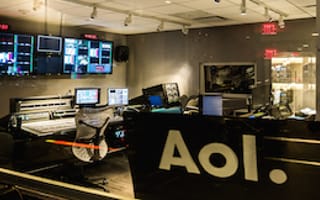When you think of AOL, most of us probably think about the infernally slow age of dial-up, one of the largest, and worst, mergers, ‘You’ve got mail,’ and this social gateway. Walking into AOL’s bustling office in Astor Place paints a different picture, and it’s anything but outdated.
The expansive, multi-story office feels more like a chic hotel than a corporate headquarters and exudes the spirited vibe typical in startup settings — but at an enormous scale. Touring the office, I pass engineers working alongside journalists, a celebrity speaking in an intimate studio space and a group of employees testing out virtual reality.

AOL's corporate headquarters in New York City.
In fact, the space doesn’t feel like it belongs to just one organization at all, but to a myriad of different companies — complete with their own cultures, technologies and innovation-driven missions. This is exactly what AOL is today: a parent company to future-forward and culturally creative brands, which include The Huffington Post, TechCrunch, Makers and Engadget, to name a few.
However, the digital content space remains crowded, and these brands are a dime a dozen in New York City’s long-standing media capital. But alongside younger tech juggernauts like Google and Facebook, and even younger publishing giants, like BuzzFeed, the pioneering ethos that established AOL as a tech giant in the pre-dot-com era sets the company apart once again.
In May of 2015, Verizon bought AOL for $4.4 billion, a hefty purchase that centered around AOL’s diverse adtech stack more than its various content brands. With a piece of technology for just about every part of digital advertising — from buying to selling to attribution to targeting — AOL’s assets are rooted in its duality as a major adtech and media conglomerate.
“We talk about ourselves as a media technology company,” said AOL’s Chief Technology Officer William Pence. “On the one hand we have a number of well-known sites that we publish, but we also have the deep technology around the underlying ad systems and the underlying publishing systems and that touches on traditional long form content, video content and now we’re getting into things like VR and AR.”

AOL's Chief Technology Officer, William Pence, in the company's New York City office.
While traditional publishers create content and sell ads to monetize, AOL uses its technology to optimize content delivery in an ultra plugged-in digital landscape. Through its deep advertising technology, the company monetizes from distributing its content to a variety of end points, catering to how today’s readers get their content across many different platforms, ranging from Facebook Live to virtual reality experiences.
To this end, AOL employs a barbell strategy in its resurgence as major technology player. On one side of things, the company’s subsidiaries include a number of content sites. On the other side, it holds a deep stack of adtech platforms. The result is a shift in global media.
With programmatic selling and extensive video technology in its arsenal, AOL‘s content properties benefit from its native ad tech and power distribution as the world increasingly consumes more media through mobile, on-demand and over-the-top services.
A champion of this objective, Pence joined AOL from WebMD in 2014, and immediately shook up the organization in order to bring new content experiences to AOL’s audiences.
“What we’re doing is taking what was, historically, an analytical framework around search engine optimization and thinking about the whole thing — we want to determine what is needed for a breaking news story, how to present that content better to the user, how to automate distributing the right articles across different end points and how to use data to determine if those articles are actually performing,” said Pence. “On the creator side we’re diverse, and on the tech side, we’re building at-scale platforms. Typically a company does one or the other, but we think that the world is increasingly converging to a point where having both is a big advantage, but it makes for a unique culture within the company.”
Pence also emphasized that AOL is heavily focused on the culture of the internet and creating new forms of content. In April, the company acquired virtual reality and 360-degree video startup RYOT. In June, AOL launched an in-house startup incubator aimed at turning its own employees into entrepreneurs.

A virtual reality studio in AOL's New York City office.
And while AOL operates as a new face of the internet, its history resides as a foundational technology company. Old impressions die hard, but throughout its 30-plus years in business, AOL has continued to pioneer over and over again.
“The overarching story and vision around this media tech company is getting better and better understood,” said Pence. “We build pipes and we build the audience, and then boom, we connect them together. So that’s pretty unique.”
Know of a company that deserves coverage? Let us know or tweet us @builtinnewyork.






